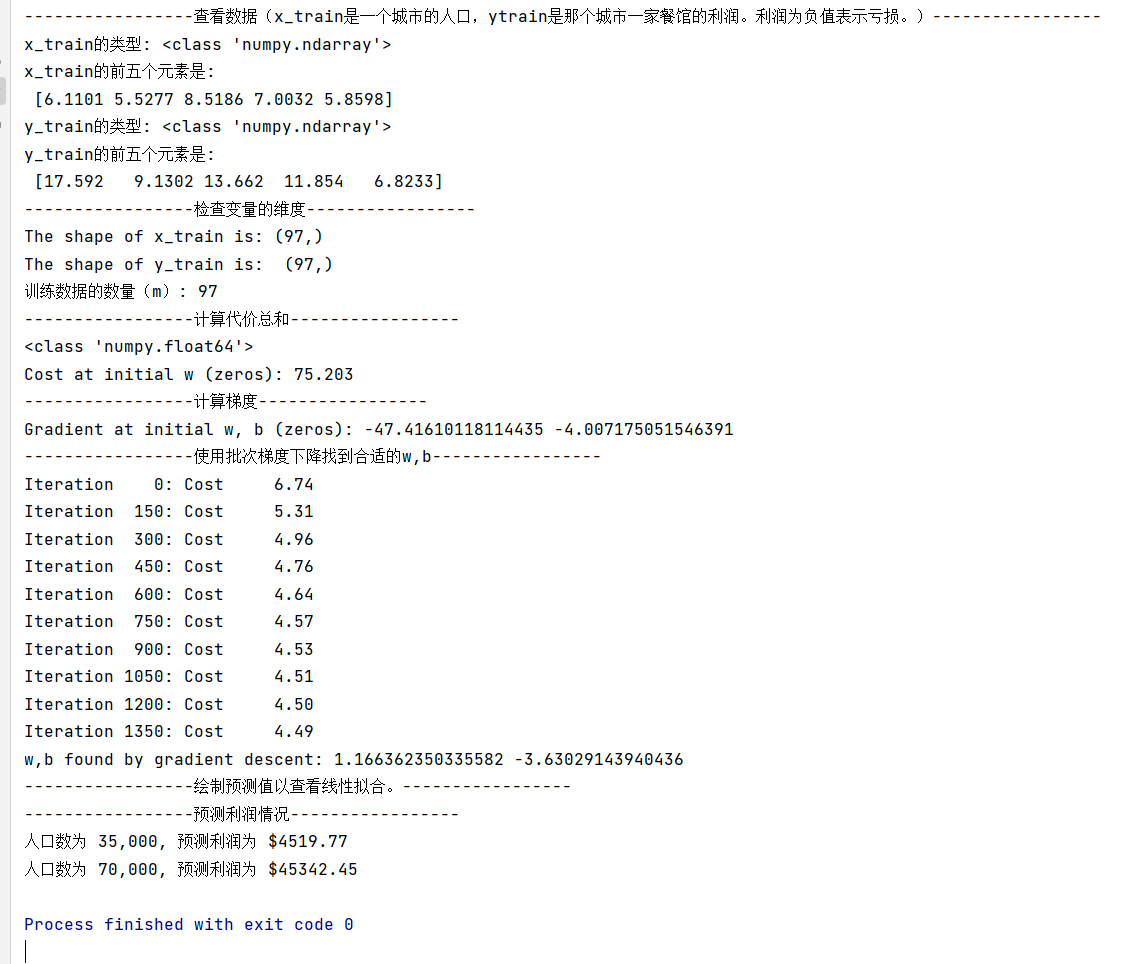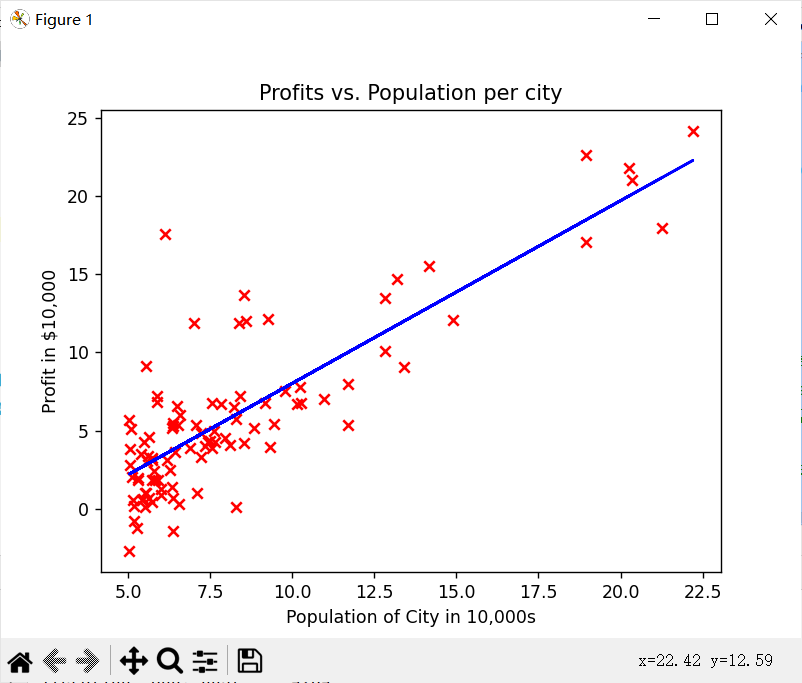C1_W2_test.py
import matplotlib.pyplot as plt
from test_Function.utils import *
from test_Function.C1_W2_testFunction import *
import copy
import math
#%matplotlib inline
if __name__ == '__main__':
x_train, y_train = load_data()
# print x_train
print('-----------------查看数据(x_train是一个城市的人口,ytrain是那个城市一家餐馆的利润。利润为负值表示亏损。)-----------------')
print("x_train的类型:",type(x_train))
print("x_train的前五个元素是:\n", x_train[:5])
# print y_train
print("y_train的类型:",type(y_train))
print("y_train的前五个元素是:\n", y_train[:5])
print('-----------------检查变量的维度-----------------')
'''检查变量的维度
熟悉数据的另一个有用方法是查看其维度。
请打印x_train和y_train的形状,并查看数据集中有多少训练示例。
'''
print('The shape of x_train is:', x_train.shape)
print('The shape of y_train is: ', y_train.shape)
print('训练数据的数量(m):', len(x_train))
'''可视化数据
通过可视化来理解数据通常很有用。
对于这个数据集,您可以使用散点图来可视化数据,因为它只有两个属性要绘制(利润和人口)。
你在现实生活中遇到的许多其他问题都有两个以上的属性(例如,人口、家庭平均收入、月利润、月销售额)。当你有两个属性以上时,你仍然可以使用散点图来查看每对属性之间的关系。'''
# 创建数据的散点图。要将标记更改为红色“x”,
# 我们使用了“标记”和“c”参数
plt.scatter(x_train, y_train, marker='x', c='r')
# Set the title
plt.title("Profits vs. Population per city")
# Set the y-axis label
plt.ylabel('Profit in $10,000')
# Set the x-axis label
plt.xlabel('Population of City in 10,000s')
plt.show()
print('-----------------计算代价总和-----------------')
'''我们的目标是建立一个线性回归模型来拟合这些数据。
线性回归的模型函数是一个从“x”(城市人口)映射到“y”(您餐厅在该城市的月利润)的函数,表示为𝑓𝑤,𝑏(𝑥)=𝑤𝑥+𝑏
𝑐𝑜𝑠𝑡(𝑖)=(𝑓𝑤𝑏−𝑦(𝑖))2
返回所有示例的总成本 𝐽(𝐰,𝑏)=12𝑚∑𝑖=0𝑚−1𝑐𝑜𝑠𝑡(𝑖)
使用该模型,您可以输入一个新城市的人口,并让该模型估计您的餐厅在该城市的潜在月度利润。
'''
# Compute cost with some initial values for paramaters w, b
initial_w = 2
initial_b = 1
cost = compute_cost(x_train, y_train, initial_w, initial_b)
print(type(cost))
print(f'Cost at initial w (zeros): {cost:.3f}')
print('-----------------计算梯度-----------------')
# Compute and display gradient with w initialized to zeroes
initial_w = 0.2
initial_b = 0.2
tmp_dj_dw, tmp_dj_db = compute_gradient(x_train, y_train, initial_w, initial_b)
print('Gradient at initial w, b (zeros):', tmp_dj_dw, tmp_dj_db)
print('-----------------使用批次梯度下降找到合适的w,b-----------------')
# initialize fitting parameters. Recall that the shape of w is (n,)
initial_w = 0.
initial_b = 0.
# some gradient descent settings
iterations = 1500
alpha = 0.01
w,b,_,_ = gradient_descent(x_train ,y_train, initial_w, initial_b,
compute_cost, compute_gradient, alpha, iterations)
print("w,b found by gradient descent:", w, b)
'''现在我们将使用梯度下降的最终参数来绘制线性拟合。 回想一下,我们可以得到单个示例的预测𝑓(𝑥(𝑖))=𝑤𝑥(𝑖)+𝑏 .
为了计算整个数据集的预测,我们可以循环所有训练示例,并计算每个示例的预测。这显示在下面的代码块中。'''
m = x_train.shape[0]
predicted = np.zeros(m)
for i in range(m):
predicted[i] = w * x_train[i] + b
print('-----------------绘制预测值以查看线性拟合。-----------------')
# Plot the linear fit
plt.plot(x_train, predicted, c = "b")
# Create a scatter plot of the data.
plt.scatter(x_train, y_train, marker='x', c='r')
# Set the title
plt.title("Profits vs. Population per city")
# Set the y-axis label
plt.ylabel('Profit in $10,000')
# Set the x-axis label
plt.xlabel('Population of City in 10,000s')
plt.show()
'''我们的最终价值𝑤,𝑏 也可以用来预测利润。让我们来预测35000人和70000人的地区的利润。 该模型以10000人的城市人口为输入。
因此,35000人可以转化为np.array模型的输入([3.5]) 类似地,70000人可以被转换为np.array([7.])模型的输入'''
print('-----------------预测利润情况-----------------')
predict1 = 3.5 * w + b
print('人口数为 35,000, 预测利润为 $%.2f' % (predict1*10000))
predict2 = 7.0 * w + b
print('人口数为 70,000, 预测利润为 $%.2f' % (predict2*10000))C1_W2_testFunction.py
import copy
import math
def compute_cost(x, y, w, b):
"""
Computes the cost function for linear regression.
Args:
x (ndarray): Shape (m,) Input to the model (Population of cities)
y (ndarray): Shape (m,) Label (Actual profits for the cities)
w, b (scalar): Parameters of the model
Returns
total_cost (float):使用w,b作为线性回归参数的成本以拟合x和y中的数据点
"""
# number of training examples
m = x.shape[0]
# You need to return this variable correctly
total_cost = 0
### START CODE HERE ###
for i in range(m):
f_wb_i = x[i] * w + b
total_cost = total_cost + (f_wb_i - y[i]) ** 2
total_cost = total_cost / (2 * m)
### END CODE HERE ###
return total_cost
# GRADED FUNCTION: compute_gradient
def compute_gradient(x, y, w, b):
"""
Computes the gradient for linear regression
Args:
x (ndarray): Shape (m,) Input to the model (Population of cities)
y (ndarray): Shape (m,) Label (Actual profits for the cities)
w, b (scalar): Parameters of the model
Returns
dj_dw (scalar): The gradient of the cost w.r.t. the parameters w
dj_db (scalar): The gradient of the cost w.r.t. the parameter b
"""
# Number of training examples
m = x.shape[0]
# You need to return the following variables correctly
dj_dw = 0
dj_db = 0
### START CODE HERE ###
for i in range(m):
f_wb_i = w * x[i] + b
dj_db = dj_db + (f_wb_i - y[i])
dj_dw = dj_dw + (f_wb_i - y[i]) * x[i]
dj_dw = dj_dw / m
dj_db = dj_db / m
### END CODE HERE ###
return dj_dw, dj_db
def gradient_descent(x, y, w_in, b_in, cost_function, gradient_function, alpha, num_iters):
"""
Performs batch gradient descent to learn theta. Updates theta by taking
num_iters gradient steps with learning rate alpha
Args:
x : (ndarray): Shape (m,)
y : (ndarray): Shape (m,)
w_in, b_in : (scalar) Initial values of parameters of the model
cost_function: function to compute cost
gradient_function: function to compute the gradient
alpha : (float) Learning rate
num_iters : (int) number of iterations to run gradient descent
Returns
w : (ndarray): Shape (1,) Updated values of parameters of the model after
running gradient descent
b : (scalar) Updated value of parameter of the model after
running gradient descent
"""
# number of training examples
m = len(x)
# An array to store cost J and w's at each iteration — primarily for graphing later
J_history = []
w_history = []
w = copy.deepcopy(w_in) # avoid modifying global w within function
b = b_in
for i in range(num_iters):
# Calculate the gradient and update the parameters
dj_dw, dj_db = gradient_function(x, y, w, b)
# Update Parameters using w, b, alpha and gradient
w = w - alpha * dj_dw
b = b - alpha * dj_db
# Save cost J at each iteration
if i < 100000: # prevent resource exhaustion
cost = cost_function(x, y, w, b)
J_history.append(cost)
# Print cost every at intervals 10 times or as many iterations if < 10
if i % math.ceil(num_iters / 10) == 0:
w_history.append(w)
print(f"Iteration {i:4}: Cost {float(J_history[-1]):8.2f} ")
return w, b, J_history, w_history # return w and J,w history for graphing运行结果:
























 229
229

 被折叠的 条评论
为什么被折叠?
被折叠的 条评论
为什么被折叠?








